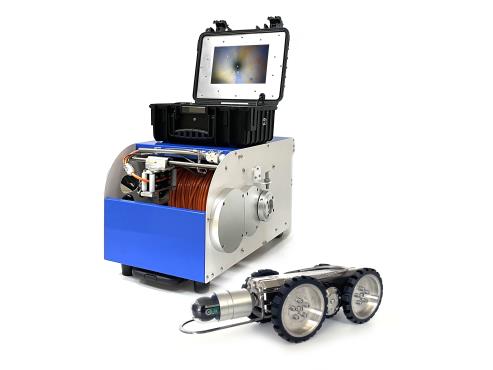Maintaining the integrity of underground pipelines is crucial for preventing costly repairs and ensuring safety. Inspections often begin at an access pipe, which serves as a crucial entry point for the camera technology used to assess and document the condition of the pipes. Traditional inspection methods can be invasive and hazardous, often requiring significant downtime. Enter video pipe inspection, a modern, non-invasive technique that allows for a thorough internal review of pipelines without disrupting operations.
JIUTAI Technology specializes in providing reliable video pipe inspection solutions, leveraging advanced robotic technology to deliver precise and reliable assessments. This innovative approach not only identifies potential issues early but also enhances safety by eliminating the need for human entry into hazardous environments. Discover how video pipe inspection can revolutionize pipeline maintenance.
What is the Process for Video Pipe Inspection?
Understanding the process of video pipe inspection is essential for appreciating its effectiveness and benefits. This modern, non-invasive method provides a comprehensive view of the internal condition of pipelines, enabling early detection of potential issues without disrupting operations. Here’s how the video pipe inspection process works.
- Preparation: The inspection begins with setting up the equipment, including a specialized video camera attached to a flexible rod or robotic crawler, and a durable camera cable that aids in the movement and operation of the camera within the pipeline.
- Insertion: The camera is carefully inserted into the pipeline through an access point. As it navigates through the pipeline, it transmits real-time video footage to a monitor above ground.
- Real-Time Monitoring: Technicians observe the live feed, carefully examining the interior of the pipeline for any signs of damage or obstruction. This immediate feedback allows for quick identification of issues.
- Recording and Analysis: The entire inspection is recorded, providing a permanent visual record. This footage can be reviewed in detail to ensure no issues are overlooked and to document the pipeline's condition over time.
- Identification of Issues: Common problems such as cracks, blockages, corrosion, root intrusions, and leaks are identified and documented. The precise location and nature of these issues are recorded for further action.
- Reporting: A comprehensive report is generated, detailing the findings of the inspection. This report includes visual evidence and recommendations for any necessary repairs or maintenance.
What Types of Problems Can Video Pipe Inspection Address?
Video pipe inspection is a powerful tool for identifying a range of common pipeline issues that, if left unchecked, can lead to significant damage and costly repairs. It helps detect potential weak points, which is crucial for identifying structural and operational defects in sewer and storm pipes, ensuring compliance with regulations and preventing future problems. By providing a clear and detailed view of the pipeline’s interior, this method allows for the early detection of problems, ensuring timely intervention. Here are some of the typical issues that video pipe inspection can uncover, including various pipe defects that are essential to identify during routine inspections.
Cracks and Fractures
Pipe segments can develop cracks and fractures due to various factors such as ground movement, pressure changes, or material fatigue. Video pipe inspection identifies these structural weaknesses early, allowing for timely repairs before they escalate into more severe problems like leaks or complete pipeline failure. By catching these issues early, operators can avoid costly repairs and potential environmental hazards associated with pipeline breaches.
Blockages and Debris Buildup
Blockages and debris buildup are common issues in pipelines, often caused by sediment, grease, foreign objects, or other materials accumulating over time. Inspecting small diameter pipes presents unique challenges, as conventional methods using a tractor mechanism may not fit. These blockages can restrict flow, leading to backups and increased pressure within the pipeline. Video pipe inspection pinpoints the exact locations of these accumulations, enabling targeted cleaning and maintenance to restore proper flow and prevent disruptions in service.
Corrosion and Rust
Corrosion and rust are significant threats to the integrity of metal pipelines. These processes degrade the material, weakening the pipeline and making it more susceptible to leaks and breaks. Video pipe inspection detects areas affected by corrosion and rust, allowing for early intervention. This proactive approach helps maintain the pipeline's structural integrity and prolongs its lifespan, ultimately saving on repair and replacement costs.
Root Intrusion
Tree roots can penetrate pipelines through small cracks or joints, causing blockages and structural damage. This is particularly common in older pipelines or those located near large trees. Video pipe inspection locates these intrusions, providing clear visual evidence of root penetration. Early detection allows for effective removal of the roots and repair of the pipeline, preventing further damage and ensuring uninterrupted flow.
Leaks and Structural Defects
Leaks and other structural defects can develop due to various reasons, including material degradation, poor installation, or external damage. Identifying leaks and structural defects in sewer pipes is crucial for maintaining the integrity of the entire system. Video pipe inspection finds these issues by providing a detailed view of the pipeline's interior, highlighting any areas where leaks or defects are present. Addressing these problems promptly helps prevent environmental contamination, loss of product, and costly repairs, ensuring the pipeline operates efficiently and safely.
With these common issues being detected early through video pipe inspection, pipeline operators can implement timely maintenance and repairs, preventing major failures, reducing downtime, and minimizing repair costs. This proactive approach not only enhances the reliability of the pipeline system but also ensures its long-term operational efficiency and safety.
When is Video Pipe Inspection Recommended?
Video pipe inspection is not just a routine check-up but a crucial necessity in certain situations to maintain pipeline integrity and functionality. In many cases, neglecting to perform these inspections can lead to severe consequences, including costly repairs, significant downtime, and potential safety hazards. Here are some key scenarios where video pipe inspection is essential:
Routine Maintenance Checks
Regular maintenance is crucial for the longevity and efficiency of pipelines. Inspecting utility lines during routine maintenance is essential to identify and locate potential issues early. Routine video pipe inspections allow for the early detection of potential issues before they become serious problems. By incorporating these inspections into the maintenance schedule, operators can proactively address minor defects, ensuring the pipeline remains in optimal condition.
After a Suspected Leak or Blockage
When there are signs of sewer line problems, such as unusual pressure drops, reduced flow, or visible water damage, a video pipe inspection becomes indispensable. It provides a precise and immediate diagnosis, allowing for quick identification of the problem's location and nature. This enables targeted repairs, minimizing downtime and further damage.
Pre-Purchase Inspections for New Properties
For prospective property buyers, a thorough inspection of the property's plumbing system is essential. Video pipe inspection offers a detailed assessment of the pipeline's condition, revealing any hidden issues that could lead to costly repairs in the future. This information is invaluable for making informed purchasing decisions and negotiating property prices.
Post-Repair Verification
After pipeline repairs or installations, video pipe inspection is used to verify the quality and effectiveness of the work done. It ensures that all repairs are correctly implemented and that no new issues have arisen during the repair process. This verification step provides peace of mind that the pipeline is functioning properly and safely.
Before Major Construction Projects Affecting Existing Pipelines
Major construction projects, such as roadworks or building expansions, can impact existing underground pipelines. Inspecting gas lines is crucial before construction to ensure safety and compliance with regulations. Conducting a video pipe inspection before such projects begin helps identify any vulnerabilities or existing damage. This preemptive measure allows for necessary reinforcements or adjustments to be made, protecting the pipeline from potential construction-related damage.
What are the Advantages of Video Pipe Inspection?
Video inspection offers significant benefits over traditional inspection methods, making it the preferred choice for maintaining pipeline integrity due to its effectiveness as a diagnostic tool. Unlike conventional techniques, video pipe inspection is non-destructive, highly accurate, and efficient. Discover the advantages of video pipe inspection below.
Non-Destructive and Non-Invasive
Video pipe inspection uses advanced camera technology to examine the interior of pipelines without causing any damage. This non-invasive method ensures that the pipeline remains intact during the inspection process, preserving its structural integrity and functionality.
Accurate and Detailed Visual Assessment
The high-resolution cameras used in video pipe inspections provide a clear and detailed view of the pipeline's interior. This level of accuracy allows for precise identification of issues such as cracks, blockages, corrosion, and leaks, enabling targeted and effective repairs.
Cost-Effective by Preventing Larger Issues
By detecting potential problems early, video pipe inspection helps prevent minor issues from escalating into major, costly repairs. This proactive approach reduces maintenance costs and extends the lifespan of the pipeline, providing significant long-term savings.
Quick and Efficient, Minimizing Downtime
Video pipe inspection is a swift and efficient process, allowing for rapid assessment and minimal disruption to operations. This quick turnaround time is particularly beneficial in industrial and commercial settings where downtime can result in substantial financial losses.
Enhanced Safety by Avoiding the Need for Manual Inspection in Hazardous Environments
Traditional inspection methods often require manual entry into confined or hazardous spaces, posing significant safety risks. Video pipe inspection eliminates the need for human entry, reducing the risk of accidents and ensuring a safer inspection process.
Choose JIUTAI Technology for Your Projects
JIUTAI Technology offers different types of inspection robots equipped with high-resolution cameras and advanced imaging technology, including pipe inspection crawler cameras, pipe push rod borescope cameras and PTZ manhole pole cameras. These robots are capable of navigating complex pipeline networks, providing clear and detailed visuals of the interior conditions, and identifying issues with pinpoint accuracy.
Whether dealing with underground pipelines, petroleum chemical pipelines, or any other type of infrastructure, JIUTAI Technology's solutions are versatile and adaptable. Our inspection systems are designed to handle a wide range of pipeline materials and configurations, ensuring comprehensive assessments regardless of the pipeline type.






